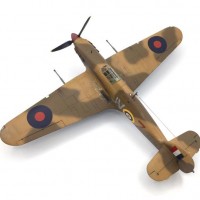1:48 Hasegawa Hurricane Mk.IID “Tank Buster”
The Battle of Britain proved that the Hawker Hurricane Mk.I's days as a front line fighter were numbered. Along came the improved Hurricane Mk IIA series in 1942 with the ability to use newly developed interchangeable wings. The airframe's new reputation as a worthy attack aircraft took off from there.
Camouflaged in desert markings, the Mk. II D variant was fitted with two 40mm Vickers S cannons slung underneath along with one 7.7mm Browning machine gun in each wing. Apparently these wing-mounted Browning's were used to fire spotting rounds for the cannons. The Mk. IID proved highly successful and was used across North Africa, the Mediterranean and throughout Southeast Asia. It became known as “The Tank Buster”.
Stashed in my pile of un-built kits for over a decade, I yanked this 1998 Hasegawa kit off the shelf and went to it shortly before this past Christmas with a two week pause along the way. The fit of this kit is really good and assembles quickly and smoothly with very little filler needed. A slight hang up is the poor fit of the clear navigation lights that are too small for their intended cut outs at the wing tips. Filler and sanding could rectify that, but I was too lazy. Rear of the canopy sits a bit high for my liking as well. A bit on the thick side seems to me. Again, careful sanding might take care of this.
The kit decals are another story and don't hold up with time so I used fresh roundels from my decal dungeon. I did use the kit supplied fuselage squadron markings that are printed to look like weathered paint but the carrier film refused to go totally transparent no matter what stuff I used so it has that “applied with Scotch tape” look.
Built almost straight OOB, the only extras I used were Quickboost resin cannons and exhausts plus Eduard PE belts. E-Z line was used for antenna wire but I think it looks way too heavy and will change that out if I ever get around to it. Acrylics used were Lifecolor, Tamiya and Vallejo cameo airbrushed freehand using my ancient but ever trusty Paasche H.
Isn't it a nice feeling to actually finish something that's been buried in the ol' stash pile for years instead of just staring at it? I really had a good time putting this Hasegawa Hurricane together.
My first completed build of 2020. Ta-da!














Nifty looking kite. For my antennae I use this...https://www.uschivdr.com/products-in-detail/rigging/ Fine thread is recommended for 1:48 but to my liking, the Super Fine looks more in scale
I usually use fine invisible thread which I did on the vertical wire going into the fuselage. I used the EZ line for the horizontal wire. What EZ line has going for it is that it stretches thin, bonds easily and instantly with superglue plus it has enough flex that when you nick it, it doesn’t snap off like thread. Downside is that it’s dark tinted and still seems out of scale for 1:48 or 1:72. Thanks for that rigging link. Looks like a valuable source.
These are two 1:48 kits I used the superfine on
https://imodeler.com/uploads/2019/05/b/blackadder57_190514_5cdb187fbc0ec.jpg?14906
https://imodeler.com/uploads/2019/04/b/blackadder57_190416_5cb6697dd61a2.jpg?17725
As you do George, I also use Super Fine 0.055mm rigging but from Infini. It is marketed for 1/72, but looks great on 1/48 in my opinion. All three of my posted builds have used this.
Great looking Hurricane! Anything looks cooler with cannons, but I've grown fond of these birds lately. Cheers to a clean build!
I think the Hurricane is somehow especially suited to desert colours. Just seems ‘right’. I like everything about this build.
‘Liked’
I agree the colors on that aircraft are really nice. Well done!
Yes, that's a good kit, and you've turned it into an excellent model.
The Hurricane will always remain an icon of WWII, with its presence in both B of B and Africa campaigns indelibly imprinted on memories of those theaters and events! Yours is a real beauty.
Looks great! Nicely done.
I've been wanting to build an Hurricane in desert colors for long. Now that I've seen yours, even more.
Nice build, congratulations!
Nicely done Eric and I ditto your comments about the kit. My only issue is the lack of building it with the canopy in the open position. Nice detail in the cockpit but it's hard to see thru that thick glass. Great camo job, she looks well with that paint.
My father-in-law flew one of these with Six Squadron RAF in North Africa and from what he has told me, this is a very accurate replication of their set-up. The JV lines up with his recall. He said there was less lettering on the sides because they were trying to keep the 2Ds a secret. The machine guns were, as far as he was concerned, primarily used to distract the tank crew during an attack, rather than help with aiming. It was close combat and plenty were shot down. He said he used the twin Brownings, "like a hose". The 2D lost ten feet in height with every pair of shells fired. They damaged prop blades in the desert training to begin an attack at 40 to 60 feet, so only 2 or 3 pairs could be fired at each target before they had to pull up. One colleague lost his tail wheel on a tank turret. The FIL had a bullet rise vertically through the main spar, between his legs and out the top of the canopy without hitting anything.